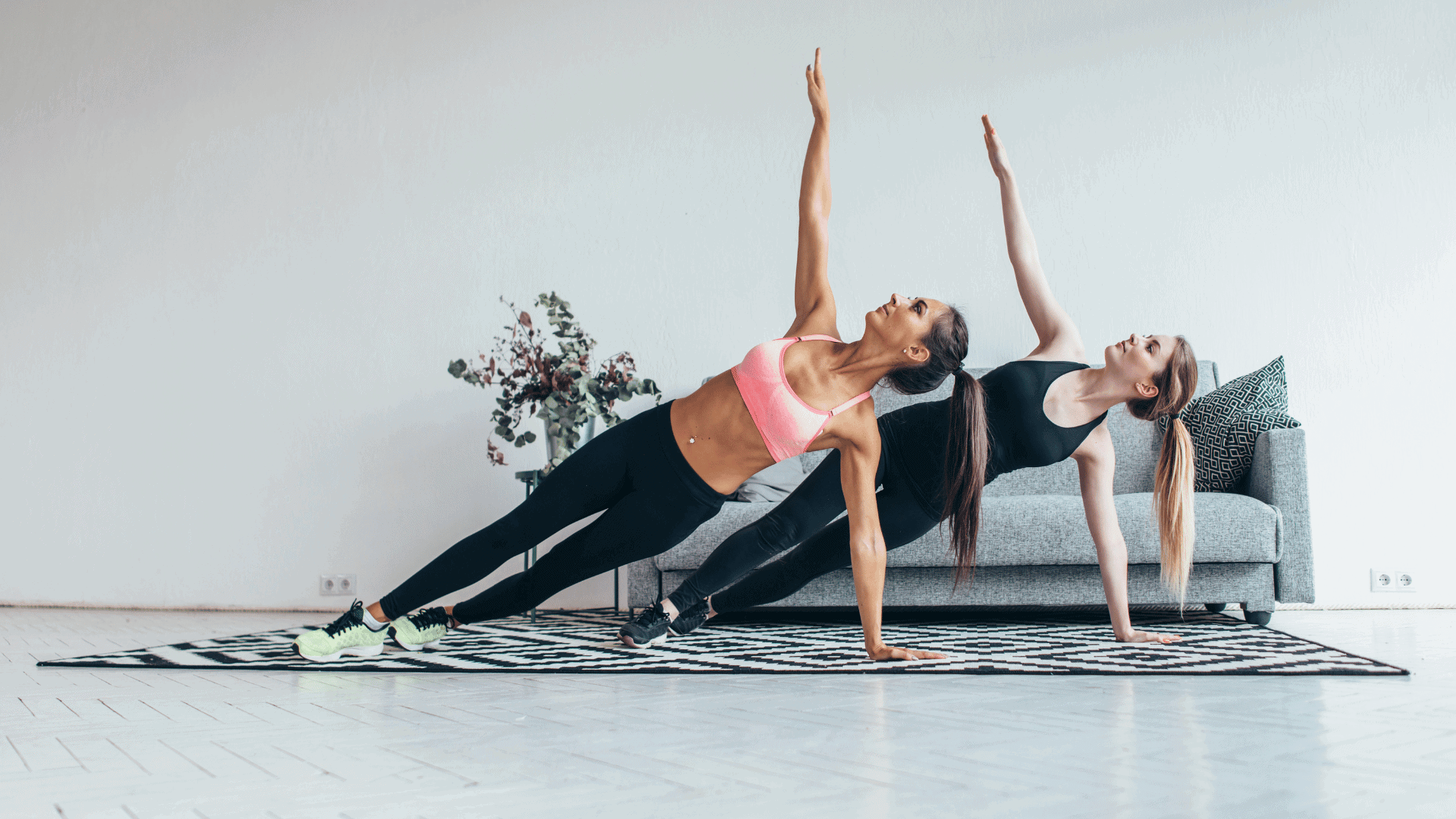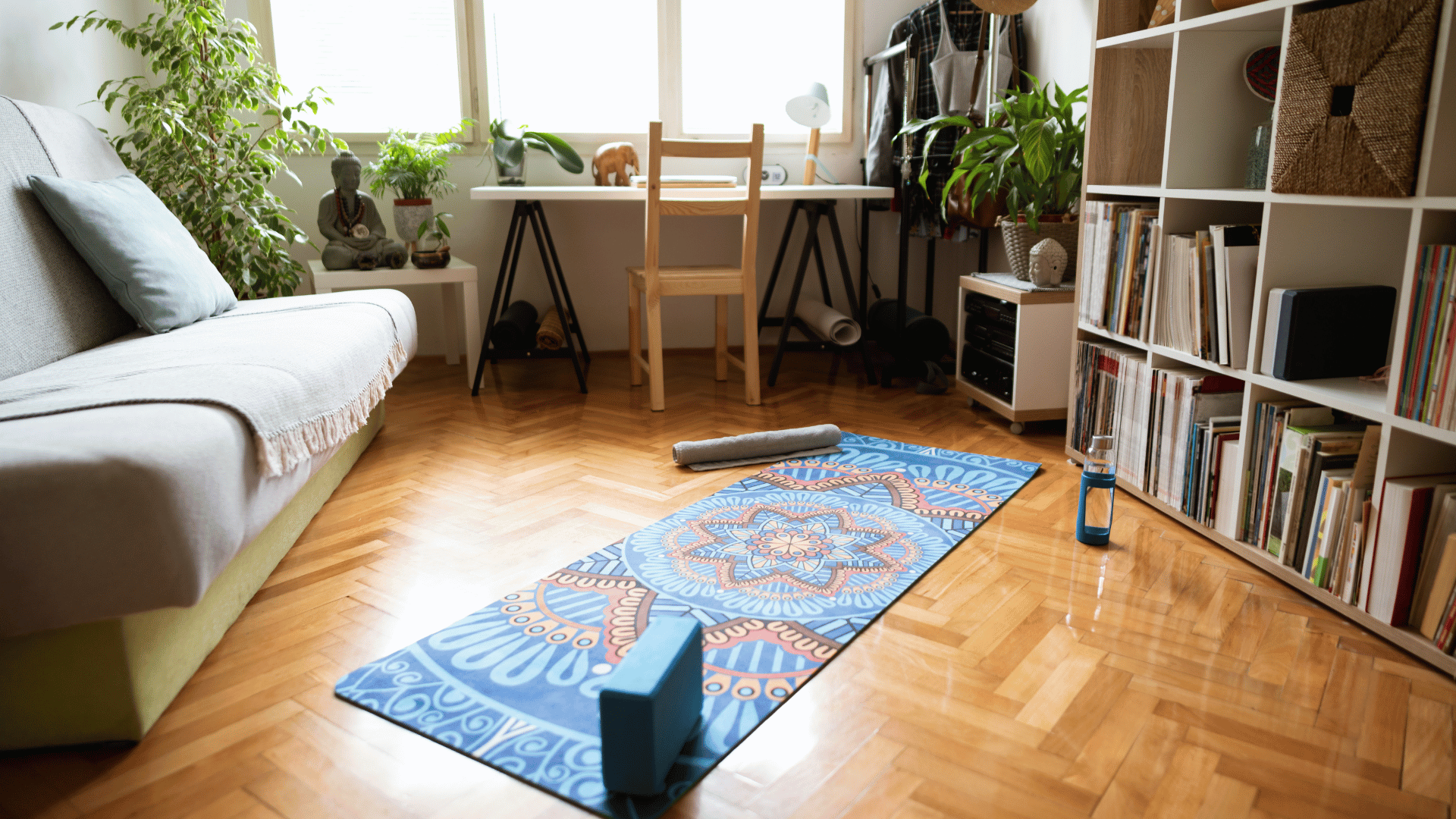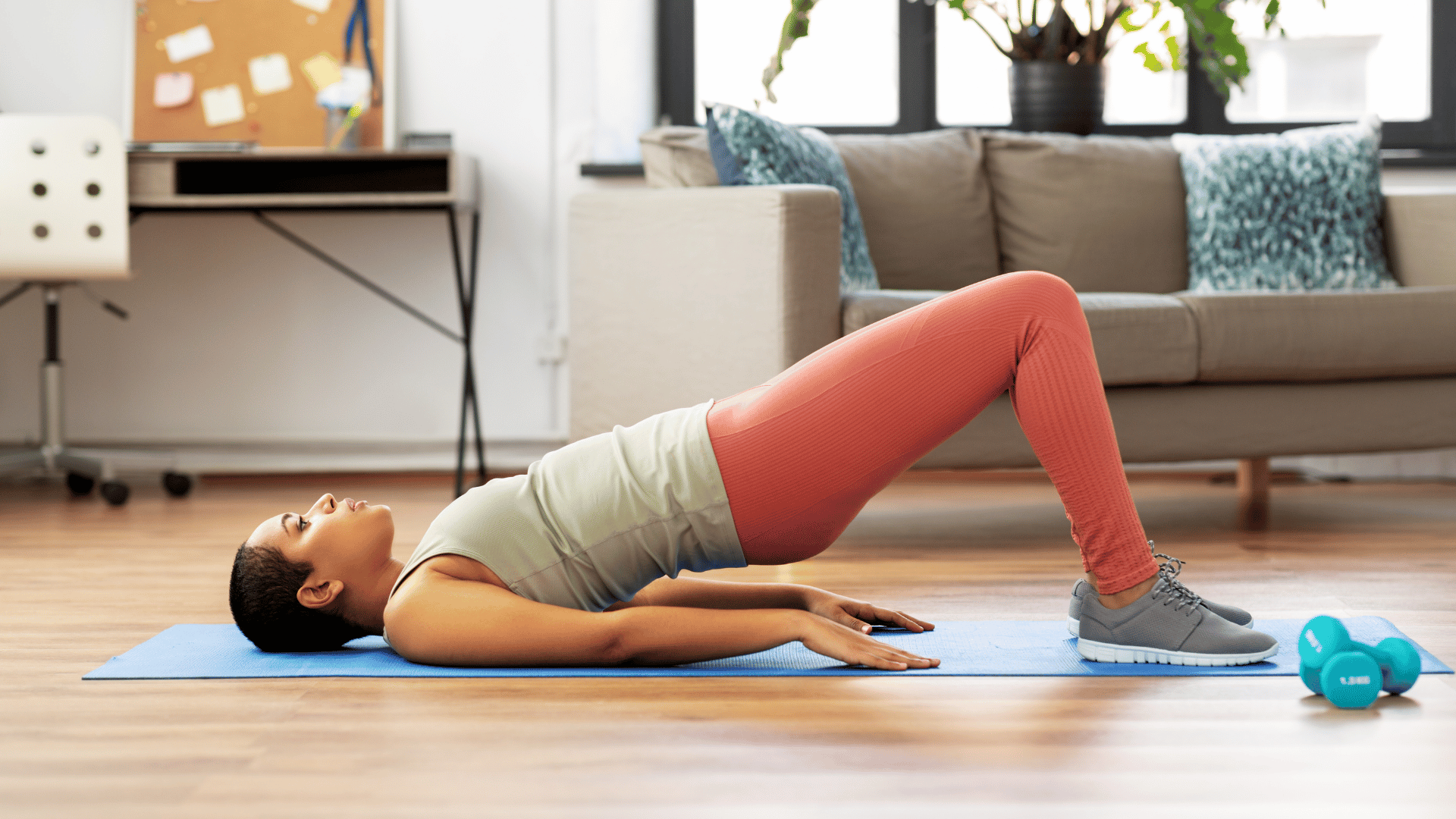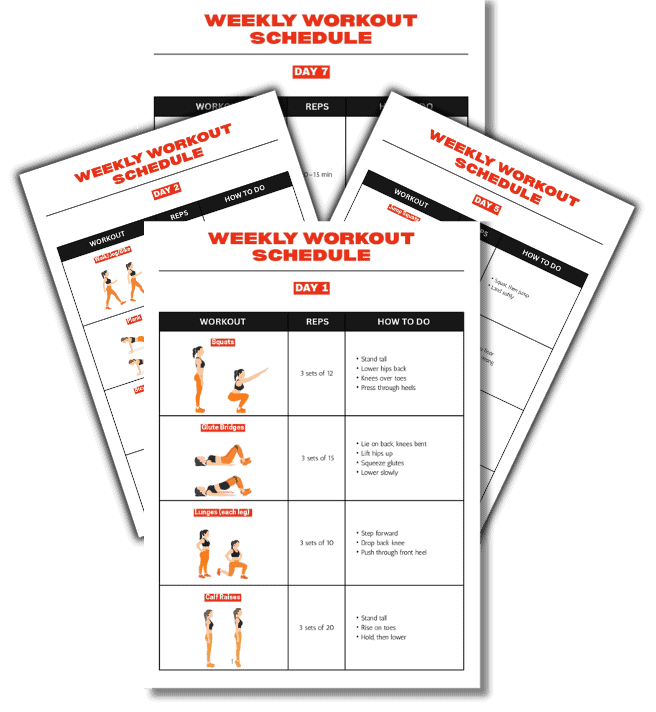Want to get stronger and feel better, without setting foot outside your home? Pilates at home is a smart and easy way to do just that.
It’s gentle on your body but packs a punch when it comes to building strength, stretching tight muscles, and calming your mind.
This workout is perfect for those busy folks who don’t have hours to spend at the gym but still want REAL results. Whether it’s your living room, bedroom, or even a tiny nook…
Pilates can fit right in.
In this guide, I’ll share simple tips and quick ideas that make Pilates at home easy and fun. Whether you’ve got just 10 minutes workout or can squeeze in a longer session, you’ll find moves that keep you strong and inspired.
So grab your mat or even just a towel and let’s get moving!
But Why Does Pilates Work So Well at Home?

There are a few reasons why doing Pilates at home works great.
First, it saves you a lot of time. (and I mean, a lot)
Because, since you’re doing it at home, you no longer need to drive to the gym. You can easily get to work out in your own space. (Maybe even in your pajamas if you want) It’s comfy, private, and fits around your day instead of the other way around.
Don’t stress about special equipment either. You can do every classic Pilates move with just a mat or a towel on the floor. Sometimes, using a resistance band or a small ball can mix things up, but you’ll still get a great workout without them.
Basically, you’ve already got everything you need to make any Pilates workout plan, right at home.
How to Set Up a Pilates Space at Home

It’s easy to think you need a fancy studio or lots of room to do Pilates, but the truth is, you can make almost any spot in your home work. Even a small corner in your bedroom or living room can become your own mini studio with just a little effort.
Start by rolling out a good mat. This will be your workout zone and your comfort zone at the same time. A mat cushions your joints and makes every move feel better. If you want to level up your routine, you can add a resistance band or a small ball, but honestly, those extras are not a must.
Next, set the mood.
Play music you love—something that energizes you or helps you chill out. The right playlist can turn an ordinary workout into something you actually look forward to.
Finally, make your space distraction-free. Put your phone on silent or leave it in another room. Clear away anything that might get in the way or pull your attention elsewhere.
The more peaceful and ready your Pilates spot feels, the more likely you are to stick with your workouts (and actually enjoy them).
Best Pilates Moves to Try at Home
If you’re new to Pilates, don’t worry. There are plenty of moves that work your core, legs, and help fix your posture, all without making you sweat buckets.
First up is the Pelvic Curl.

This move wakes up your lower back and hips.
To do it, lie on your back with your knees bent and your feet flat on the mat. Press your feet into the floor, squeeze your glutes, and slowly lift your hips toward the ceiling, one vertebra at a time. Pause at the top, then lower down just as slowly.
Not only does this exercise strengthen your hips and back, but it also feels great after a long day of sitting.
Next, try the Chest Lift.
If you want a stronger core and better posture, this move is a MUST.
Lie on your back with knees bent, feet flat, and hands behind your head. Inhale, then exhale as you gently lift your head and shoulders off the mat. Keep your belly pulled in and avoid tugging on your neck. Lower back down with control.
This move targets your abs and supports your posture, without straining your neck or back.
After that, move on to Leg Lifts.

This is a great way to work your legs and core at the same time. Lie on your back with your arms by your sides. Keep one leg straight on the floor, and slowly lift the other leg up toward the ceiling, then lower it back down. Then, switch sides after a set.
Go slow and steady, and don’t let momentum do the work for you. You’ll really feel your lower abs and legs working together.
Finally, try Side Kicks.
For this one, turn onto your side with your legs straight and stacked. Prop yourself up on your elbow. Lift your top leg up and kick it forward, then back. Remember to keep your belly tight and hips steady.
This exercise tones your hips and outer thighs, and it also builds control in your core.
All in all, the key to Pilates is moving slowly and with good form. Focus on your posture, keep your core engaged, and remember to breathe deeply through every move.
Even if you only have 10 or 20 minutes, you can still see real benefits. Just fit these moves in a few times a week and you’ll start to feel stronger and more balanced. (And yes, you might even stand a little taller!)
How to Build a Pilates at Home Workout Plan
To see the best results, aim to do Pilates at home about 3 to 5 times a week. This gives your body a good balance of movement and rest.
You don’t have to do it every day; consistency is what really counts.
It’s also smart to mix Pilates with some light cardio or stretching on your off days. Walking, gentle yoga, or even dancing can keep you moving without wearing you out. This mix helps your body stay balanced and your workouts feel fresh.
Speaking of fresh, don’t be afraid to switch up your moves every week or two. Trying new exercises or changing the order keeps your muscles guessing and stops boredom from sneaking in.
Plus, it helps you get stronger and even more flexible over time.
Tips to Stay Inspired and Consistent When Doing Pilates Solo
Working out alone can sometimes feel a bit… well, lonely. But with a few tricks, you can keep your Pilates workout motivating and fun.
First, turn up the music. Pick your favorite songs or calming tunes, whatever helps you get in the zone. You can also use timers or workout apps to keep track of your moves and rest times. It’s like having a coach in your pocket cheering you on.
Next, don’t stress about tracking every little detail. A simple way to check progress is to notice how your body feels, are you less stiff? Holding poses longer? Feeling stronger? These small wins matter more than numbers on a screen.
Finally, be kind to yourself.
Pilates is a journey, not a race. Celebrate every time you roll out your mat, no matter how long or short your session is.
Those little things add up and keep you moving forward.
How Can You Adjust Pilates to Match Your Mood?
Everyone has days when energy is high and days when it just isn’t. That’s totally normal—and one of the best things about Pilates is how easy it is to match your workout to how you feel.
Let’s say you wake up feeling sluggish or you only have a few minutes before work. In that case, stick with a short, energizing routine.
Quick core moves, some gentle leg lifts, or even a few stretches can wake up your body and help you shake off the morning fog. (You don’t have to go all-out for it to count)
However, on days when you feel stressed or have trouble winding down, try slowing things down with deep-breathing and gentle morning stretches.
Focus on moves that relax your back, hips, and shoulders. These slower routines help calm your mind and release tension, perfect before bed or after a long day.
Of course, there will also be times when you’re not at 100%, maybe you’re sore or dealing with an old injury. When that happens, listen to your body. You can make moves easier by using extra support, moving slower, or even skipping anything that feels tough.
Remember, taking care of yourself keeps you on track for the long run.
No matter what kind of day you’re having, Pilates can be adapted to fit your mood and energy. It’s all about tuning in to how you feel and moving in a way that helps you feel better, both during and after your workout.
(And honestly, some movement always beats no movement at all!)
Want to Start Pilates at Home?
Taking that first step and rolling out your mat is all it takes to begin feeling stronger, more flexible, and more relaxed right in your own space. Pilates at home can fit into any routine, whether you have five minutes before work, need a mid-day stretch, or want a longer session on the weekend.
You don’t have to be perfect or do every move. Just start with a few exercises and see how your body responds. Every small session you complete builds momentum and confidence.
Over time, those small efforts add up to real changes in how you feel and move.
If you’re ready to give it a try, remember to go at your own pace and make each workout fit your day.
And hey, if you have questions or want to share how it’s going, leave a comment or send a message. Your story might be just what someone else needs to hear to get moving, too.
So grab your mat, press play on your favorite music, and enjoy discovering what Pilates at home can do for you.
(Trust me, you might end up loving it more than you think!)
Turn Your Living Room Into a Workout Space

Pilates at home can feel effortless when you know exactly how it fits into your week.
The challenge isn’t learning the moves — it’s staying consistent and making sure they become part of your routine.
That’s where the Free Weekly Workout Schedule comes in. It’s designed to take away the planning stress and show you how to structure your week with a mix of Pilates and other simple workouts.
This way, you can focus on moving, stretching, and feeling stronger without wondering what’s next.
Even if you’re short on time, this guide helps you stay balanced and motivated, making it easier to keep showing up day after day.
Frequently Asked Questions (FAQ)
1. Can beginners really get results at home?
Absolutely! Pilates is perfect for beginners. You can start slow, learn the moves, and build strength and flexibility right in your living room.
2. Do I need special equipment?
Not at all. A mat or a towel is all you really need to get started. Optional props like bands or balls can spice things up but aren’t required.
3. How long does it take to see changes?
Most people notice they feel stronger and more flexible within a few weeks. The key is to be consistent, even if it’s just a little bit each day.
4. What if I miss a day?
No worries! Life happens. Just jump back in when you can. Pilates works best with regular practice, but it’s okay to skip sometimes.
5. Can Pilates help with stress and sleep?
Yes! Pilates uses deep breathing and gentle moves that help calm your mind. Many people find it easier to relax and sleep better after a Pilates session.










